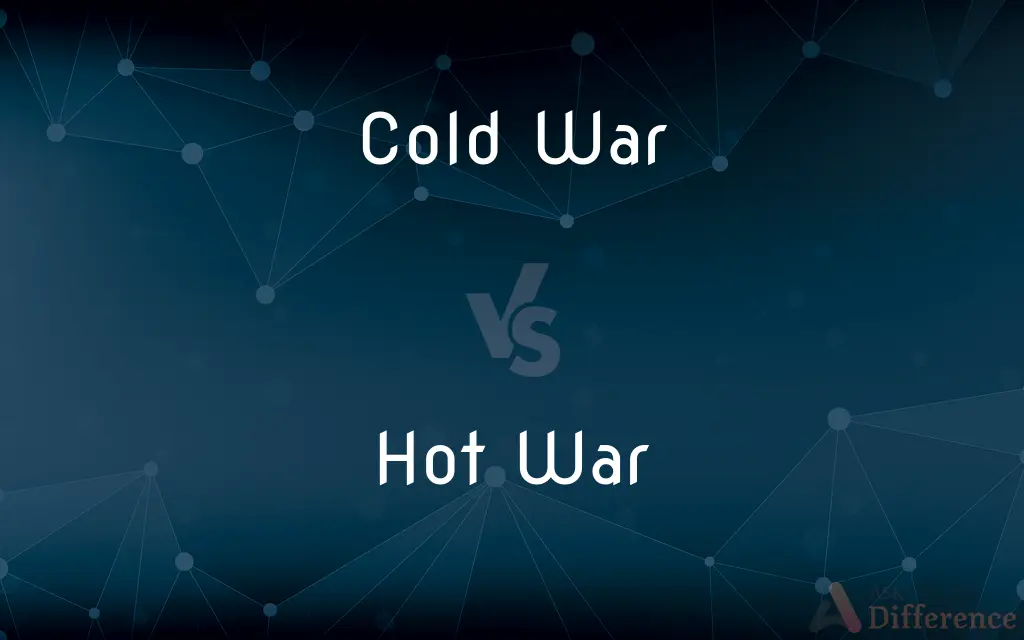Cold War vs. Hot War — What's the Difference?
By Tayyaba Rehman — Published on January 2, 2024
A Cold War is a state of political tension and military rivalry without direct warfare, while a Hot War involves active, open armed conflict between nations.

Difference Between Cold War and Hot War
Table of Contents
ADVERTISEMENT
Key Differences
Nature of Conflict: A Cold War is characterized by political tension, espionage, propaganda, and economic battles without direct military engagement between the main opponents. In contrast, a Hot War involves direct military confrontation, with active battles and use of armed forces.
Examples and Historical Context: The term Cold War most famously refers to the post-World War II tension between the USA and the USSR, marked by a nuclear arms race and ideological conflict. Hot Wars, such as World Wars I and II, involve direct, open combat with significant military casualties and destruction.
Strategies and Tactics: In a Cold War, strategies include diplomacy, espionage, economic sanctions, and proxy wars, focusing on indirect means to gain advantage. Hot Wars involve direct military strategies, including battles, invasions, and air strikes.
Impact on Global Politics: Cold Wars often lead to global polarization and alliances based on ideology, as seen in the Eastern vs. Western blocs during the 20th century. Hot Wars, meanwhile, cause widespread destruction and lead to significant political and territorial changes.
Duration and Resolution: Cold Wars are generally long-lasting, with sustained periods of tension and competition. Hot Wars, although potentially devastating, usually have more definitive endings, often marked by treaties or surrender.
ADVERTISEMENT
Comparison Chart
Nature of Conflict
Political tension, no direct military engagement.
Direct military confrontation and combat.
Strategic Focus
Espionage, economic sanctions, proxy conflicts.
Direct military operations and tactics.
Historical Example
USA vs. USSR post-WWII.
World Wars I and II.
Global Impact
Ideological polarization and alliances.
Territorial and political changes, destruction.
Duration and Resolution
Long-lasting with indirect competition.
Definitive endings with treaties or surrender.
Compare with Definitions
Cold War
A Cold War is a state of political and military tension without direct warfare.
The USA and USSR engaged in a Cold War, marked by the space race and nuclear arms competition.
Hot War
Hot War involves direct military tactics like battles and invasions.
The invasion of Normandy was a pivotal moment in the Hot War of World War II.
Cold War
Cold War includes a competition for technological and political supremacy.
The Cold War era saw intense competition in space technology.
Hot War
Hot War often ends with treaties or surrender.
The Hot War of World War I concluded with the Treaty of Versailles.
Cold War
Cold War is characterized by sustained periods of geopolitical tension.
The Berlin Wall was a symbol of the Cold War tensions in Europe.
Hot War
A Hot War is an active, open armed conflict between countries.
World War II was a Hot War with widespread military engagement across continents.
Cold War
A Cold War is marked by proxy wars and ideological confrontations.
The Vietnam War was a significant proxy battle during the Cold War era.
Hot War
Hot War causes significant destruction and human casualties.
The Hot War in Vietnam resulted in massive civilian and military casualties.
Cold War
Cold War involves indirect conflict like espionage and economic sanctions.
During the Cold War, many countries faced economic sanctions as part of the global ideological struggle.
Hot War
Hot War includes the mobilization of a nation's full military capabilities.
During the Hot War phase of the Korean conflict, both sides mobilized large armies.
Common Curiosities
What is a Cold War?
A state of political and military tension without actual warfare.
Are there casualties in a Cold War?
Indirectly, yes, especially in proxy wars, but not from direct conflict.
What defines a Hot War?
An active, open conflict involving military forces.
Did the Cold War involve nuclear conflict?
No, it involved nuclear competition but not actual use.
How long did the Cold War last?
Approximately from 1947 to 1991.
What are the key features of a Hot War?
Direct military engagement, battles, and significant casualties.
Was the Korean War part of the Cold War?
Yes, it was a proxy war during the Cold War era.
How do Hot Wars typically end?
Usually with peace treaties or the surrender of one side.
What ended the Cold War?
The dissolution of the Soviet Union marked its end.
Did the Cold War include space exploration competition?
Yes, the space race was a major aspect of it.
Can Cold Wars impact global politics?
Yes, they often lead to global alliances and ideological divisions.
Can a Cold War turn into a Hot War?
Yes, if tensions escalate to direct military conflict.
What's an example of a Hot War?
World War II is a classic example.
Do Cold Wars involve direct battles?
No, they involve indirect forms of conflict.
Are Hot Wars usually global?
They can be, but not necessarily; they can also be regional.
Share Your Discovery

Previous Comparison
Static Memory Allocation vs. Dynamic Memory Allocation
Next Comparison
SVG vs. EPSAuthor Spotlight
Written by
Tayyaba RehmanTayyaba Rehman is a distinguished writer, currently serving as a primary contributor to askdifference.com. As a researcher in semantics and etymology, Tayyaba's passion for the complexity of languages and their distinctions has found a perfect home on the platform. Tayyaba delves into the intricacies of language, distinguishing between commonly confused words and phrases, thereby providing clarity for readers worldwide.
















































